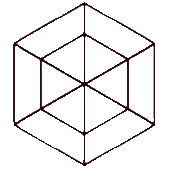1758 words
Parent: T.00_ED_TEXTUAL HOLOGRAM: PRESENTATION
TRANSPARENCY
Source: Elie During, “The Ghosts of Transparency”, in Aurélie Pétrel, Paris, ExposerPublier, forthcoming.
Architecture is fundamentally an art of movement; specific to it is a heterogeneous “spatium” that, in fact, pertains to duration. This somewhat paradoxical statement contains nothing revolutionary. Considered from the perspective of its arrangement in space, architecture appears as a “frozen music”—thus was it described by Schelling two centuries ago. But to clarify this and reach beyond the truism that volumes are experienced through motion, we need to pay attention to the way architectural form reconfigures time at a more abstract level—that of virtual and in fact non-figurable configuration spaces suggested by the potential developments and projections of certain geometrical constructions.
Eisenman often insists that form is based on a logic of space—that is, on a syntax—, but the radical nature of his approach comes from the fact that he does not limit the scope of his investigation to geometric or even topological transformation groups. His aim is to account for what is specific about architectural experience: effects such as the parallactic shifts induced by relative motion, and more generally the subtle dynamics underlying the unfolding of architectural form.
This extension of the habitual meaning of “space” stems from the architect’s reflection on “generic forms”, i.e., forms freed from their specific functions and symbolic associations: “It is not a question of our liking or disliking a cube, it is a question of our accepting its existence and recognizing its inherent properties” (Peter Eisenman, “Towards an Understanding of Form in Architecture” (1963), in Eisenman Inside Out: Selected Writings 1963-1988. New Haven: Yale University Press, 2004, p. 5-6). Yet it is worth noting that this attachment to the generic character of forms does not gain much from being considered under the category of “formalism”. In fact, in his earliest writings Eisenman insisted that the form seen in its genericity in no way reduced it to its geometrical or pictorial essence (the two are usually confused, which is the crux of the problem). From the outset, the form should integrate a temporal and somatic dimension, that is to say “a large number of experiences […] accumulated over a much longer time span than is required for the initial appreciation of a pictorial work, and building up into a conceptual, not perceptual, whole” (ibid., p. 9). In short, architectural form is a “Gestalt” of a conceptual nature but it can only be apprehended through a sort of precipitate of experiments (not exclusively visual), which provide it with a specific temporal density. Eisenman referred to this as “somatic memory” that is somehow incorporated in the generic form. Architecture aims at achieving the integration or formal synthesis of a plurality of sensory perspectives. It is more material and less abstract than painting, since it consists of real objects in a space that is not simulated, but constructed on the same level as that occupied by the feeling body. It is at once more generic, more formal, because it can only accomplish this perceptive synthesis by establishing a system of relationships that must be apprehended at a conceptual level, according to categories that have no direct sensitive counterpart, such as flatness, frontality or obliquity. “Frontality is not an empirical relationship, but rather is implied from the particular placement of form in a specific context,” writes Eisenman (“From Object to Relationship II: Casa Giuliani Frigerio: Giuseppe Terragni Casa Del Fascio”, Perspecta, vol. 13-14, April 1971, p. 39). One thinks of the lesson that Colin Rowe once gave him in front of a Palladian villa: “Tell me something about what you are looking at that you cannot see!” (Palladio Virtuel. New Haven: Yale University Press, 2015, p. 11). In that regard, frontality can entirely do without the configuration usually associated with the facade: the elevation of an architectural plane intersecting lines of sight at right angles. An image can be seen sideways and nevertheless contribute, on the aesthetic level, to reinforcing an overall feeling of frontality, provided that the forms are apprehended at a deeper level than what is suggested by the mere interplay of visual appearances.
This level of depth corresponds to that of the syntax of forms, beyond their semantic associations. It concerns, in short, the order of relationships or connections between objects, rather than the objects themselves. It is at this level that the paradoxes and ambiguities that so fascinate Eisenman arise, for example the oscillations between full and hollow, between additive and subtractive processes, or even better, the effects of superposition and simultaneity between the two. Eisenman initially refers to additive planar structures (through stacking or the stratification of vertical planes) and subtractive volumetric structures (brought about by recesses or incisions within the solid). It is possible that the two structures are practically indistinguishable. This is the meaning of the examples that follow.
The volume-plane ambiguity and the dual readings it generates are at the principle of an abstract kinematics where a façade, for example, can be read indifferently and simultaneously as if it had been augmented and extended by a series of planes, or cropped instead from the outside to reveal an interior volume, perceived as full. Are we dealing with a planar stratification, or a hollowed-out whole? Both readings are possible, and the constant slide from one to the other induces a kind of virtual movement. By engaging in a similar analysis of a construction by Giuseppe Terragni, Eisenman notes that a line of windows intercepting an ambiguous structure, midway between the floor and the ceiling, creates the “condition of a shear” which in turn irresistibly suggests a movement of the entire building onto itself: along the horizontal window slots, “the solid seems to be shifted” (“From Object to Relationship II: Casa Giuliani Frigerio: Giuseppe Terragni Casa Del Fascio”, p. 48). This type of phenomenon is even clearer when we adopt, on a structure dominated by frontality, an oblique point of view (“where the corners are articulated as a meeting of planes rather than as an edge of a volumetric solid”). Full volumes and planes constantly exchange places: “because these solids read as having been moved through a membrane, this gives the facade a planar quality”; “when viewed frontally, the facade can be read as a flattened solid” (ibid., p. 55).
Thus, signs and traces move and come together again; the forms slide over and into each other and redeploy themselves in new dimensions. The space of these virtual movements, all executed at the same time on the plane of conceptual representation, finds its emblem in Necker’s famous cube. Drawn in axonometric perspective, its contradictory directions coexist so obviously that we can maintain the illusion of being able to perceive them at once. This is what “transparency” is about (See Colin Rowe and Robert Slutzky, “Transparency: Literal and Phenomenal”, Perspecta, vol. 8, 1963, p. 45-54).
From the hypercube to Necker’s cube, we cross a threshold of abstraction, or of formality, towards “generic forms” and relational structures, which according to Eisenman, enjoy a “latent” existence under their external appearance. Ultimately, that is what really counts for the artist who engages with an architectural project: the reality of space is intensified by the formal relations implied within in it (Pet “Cardboard Architecture”, Casabella, 374, February 1973, p. 17-31). However, the privileged mode of this intensification is movement. It is the set of implicit movements folded within architectural structure, and manifested conceptually through the play of formal operations, which gives new potential to space and enables us to produce a mental image of the environment that is different from what we actually see. It is a matter of displacing space rather than molding it or giving it shape (“Real and English: Destruction of the Box, 1”, Oppositions, 4, October 1974, p. 5-34). For this reason, the actual movements that result from such a transformation are below or on the threshold of visibility: we could join Bergson in saying that these express absolute mobility—“mobility without something moving”.
This movement, which we should qualify in turn as “generic” also presupposes a relationship with time that is different from the one governing the Renaissance pictorial plane. As a matter of fact, from Palladio onwards, architecture became more and more clearly detached from that temporal order (see “The Representations of Doubt: At the Sign of the Sign”, Rassegna, 9, March 1982. Reproduced in Eisenman Inside Out, op. cit., p. 143-145). Time could no longer the sequential order of the narrative, arranged in scenes and tableaus. With Palladio, it is already something other than the perspectival time organized by a projective space, with its horizons, lines of flight and points “at infinity”, guiding the eye as it explores the painting’s depth of field. As Eisenman understood it, the “architectural promenade” advocated by Le Corbusier had little to do with the system of proportions and geometric relationships characteristic of the pictorial plane of representation: brought back to its formal principle, the idea was to allow a structure to unfold multiply in space and to maintain its different projections in a state of superposition and transparency (Palladio Virtuel, op. cit., p. 13). It remains to be seen which concept of time manages to capture this new situation.
Despite the motor suggestions associated with the term “promenade”, the temporal frame envisaged by Eisenman for architecture is essentially formal: it is the proto-time of the virtual overflow, the floating time of architectural signifiers, constantly displaced and recombined beyond any image; the time of unstable structures and their multiple projections by means of diagrams or “cardboard architecture”. When the building merges with its own axonometric projection, it is possible that a floor transforms into a ceiling on which one can walk (“The Representations of Doubt: At the Sign of the Sign”, in Eisenman Inside Out, op. cit., p. 148-149). But this transformation is instantaneous, it is, so to speak, without memory; it has nothing to do with what could constitute, beyond the architectural form proper, the living experience of the house as a sign of the habitat. With House I and House II, Eisenman pushes this disjunction of form and function to their extreme consequences; he accelerates the dislocation of the image to the extent of making the actual house a representation of its own scale model (ibid., p. 151). Is the time that governs such operations amenable to lived experience?
Links
︎ egs.edu/biography/elie-during ︎ parisnanterre.fr/m-elie-during--697698.kjsp
From the same writer
T.00_ED_TEXTUAL HOLOGRAM: PRESENTATION T.01_ED_FOLDS AND PIXELS T.02_ED_DIGITAL SUBLIME T.03_ED_MATHEMATICAL SUBLIME T.04_ED_IMMANENT SUBLIME T.05_ED_NEXUS T.06_ED_KINKED CLASSICISM T.07_ED_LOOSE COEXISTENCE T.08_ED_FLOATING TIME T.09_ED_FLOATING SPACE T.10_ED_RETRO-FUTURES T.11_ED_EXITING VIRTUAL REALITY T.12_ED_BULLET TIME T.13_ED_GHOST TIME T.14_ED_SUBLIMINAL TIME T.15_ED_DIAGRAMS OF COEXISTENCE T.16_ED_VOLUME-IMAGE T.17_ED_VERTICAL TIME T.18_ED_TURNING MOVEMENTS T.19_ED_SUPERTIME T.20_ED_PROTOTYPE T.21_ED_ZERO-G ARCHITECTURE T.22_ED_SHOCK SPACE T.23_ED_TRANSPARENCY






